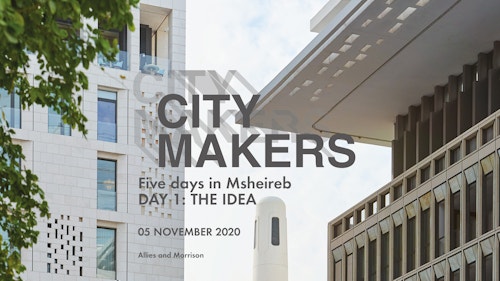/ Citymakers - Five Days in Msheireb: The Idea
Is there a place for tradition and modernity to coexist in new urban development?
Msheireb Downtown Doha is a new, compact, walkable neighbourhood knit together by naturally cooled streets built at a human scale. Set in the heart of Qatar's capital city, there are more than 100 contemporary buildings, each distinct yet all expressing a shared architectural language rooted in the local culture and climate.
One of the largest projects we have been involved with as a practice, we presented a series of five online seminars exploring Msheireb as it reaches completion. Moderated by Paul Finch, the series brought together developers, planners, academics, journalists and collaborators to a virtual exploration of a new, significant sustainable project that transforms the heart of Doha. The first day explored the origins of the project and its aspiration to be a bridge between modernity and tradition.
Opening the day, and the series, Paul Finch reflects on the anywhere skyline of Doha's West Bay, currently the eponymous vision of the city, as a foil to the compact, tightknit Msheireb Downtown Doha, asking "does tradition trump modernity? Or does modernity replace tradition?" Msheireb combines modernity and tradition.
Fatima Fawzy, of Msheireb Properties, and our Simon Gathercole follow with two presentations. Fatima shares how Msheireb was born with the desire to retain cultural roots upon which Doha was founded, blending the best of the historic city - narrow streets, the use of local materials, architecture of its place and culture, design for climate - with a model for development innovation on a large scale. Simon takes the audience on a journey through Msheireb's streets, pointing out the many different experiences and elements now encountered on these: from the many pedestrian walkways, side streets offering precious shade between buildings, the revealing and concealing of the cityscape to the widening of spaces for different activities.
Key listeners Ian Gardner, formerly of Arup and Kevin Underwood, the principal in charge of the EDAW masterplan team, offer their reflections on the masterplan's inception. Both of them were involved at the outset in 2006 with the Qatar Foundation's initial brief to create a dense walkable downtown core.
Offering an outsider's perspective to the project, Salma Samar Damluji, Mu'allim Awad Binaldin Chair for Professor of Architecture in the Islamic World at the American University of Beirut, wraps up by interrogating the social demographics of Msheireb as a piece of the city, and speculates on what the desire to reinvent heritage at scale, holds for the future of architecture in the region.

